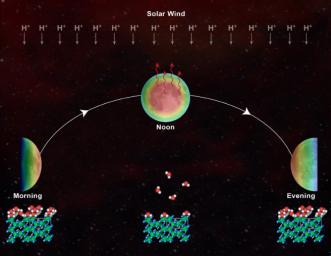skip to navigation

|
Daytime Water Cycle on the Moon
- Click the image above for a larger view
- Full-Res JPEG (800 x 618) (49.1 kB)
- Full-Res TIFF (800 x 618) (1.5 MB)
Caption:
This schematic shows the daytime cycle of hydration, loss and rehydration on the lunar surface. In the morning, when the moon is cold, it contains water and hydroxyl molecules. One theory holds that the water and hydroxyl are, in part, formed from hydrogen ions in the solar wind. By local noon, when the moon is at its warmest, some water and hydroxyl are lost. By evening, the surface cools again, returning to a state equal to that seen in the morning. Thus, regardless of location or terrain type, the entire surface of the moon is hydrated during some part of the lunar day.
This theory is based on data from NASA's Deep Impact mission.
Cataloging Keywords:
| Name | Value | Additional Values |
|---|---|---|
| Target | Moon | |
| System | Earth | |
| Target Type | Satellite | Moon, Comet |
| Mission | Deep Impact | |
| Instrument Host | Deep Impact | |
| Host Type | Impactor | |
| Instrument | ||
| Detector | ||
| Extra Keywords | Color, Impact, Water | |
| Acquisition Date | ||
| Release Date | 2009-09-24 | |
| Date in Caption | ||
| Image Credit | University of Maryland/McREL. | |
| Source | photojournal.jpl.nasa.gov/catalog/PIA12221 | |
| Identifier | PIA12221 | |
